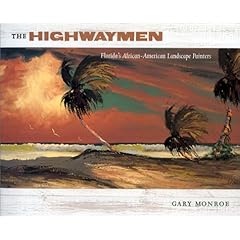Gary Monroe, author of “The Highwaymen, Florida’s African-American Landscape Painters”
Gary Monroe, Author and Expert on
Florida Highwaymen Painters
Puts Spady Museum Exhibit in Perspective June 17
Private Collection Show Runs Through June 30

Delray Beach, FL – May 26, 2009 – Author and researcher Gary Monroe thought he would be taking a brief hiatus from his work as a documentary photographer to write a “little book” on the rarely mentioned history of the Florida Highwaymen.
In the years before his book was published in 2001, virtually nothing was written about the black painters who swiftly created stunning landscapes in the 1960s and 70s and sold them so quickly on Florida’s eastern highways that the paint was rarely dry during the sales.
On June 17, Monroe will speak about his “little book” – The Highwaymen, Florida’s African-American Landscape Painters – and his research that not only awakened a deep appreciation for the art, but also blossomed into a project so large he is just returning full-time to his photography eight years later. During that period, he also wrote Harold Newton: The Original Highwayman (2007) and The Highwaymen Murals: Al Black’s Concrete Dreams (2009).
The lecture will be held at 5:30 p.m. at The Delray Beach Library, 100 West Atlantic Avenue. RSVPs are required. RSVP by visiting www.spadymuseum.org; a $5 donation is requested for attendance. For more information, call 561-279-8883.
Monroe’s one-hour, illustrated lecture is made possible by The Spady Cultural Heritage Museum, which is exhibiting a special collection of Florida Highwaymen paintings through June 30. The show focuses on paintings of two of the original Florida Highwaymen painters, Alfred Hair and Harold Newton. The exhibition, rarely displayed for the public, is entirely from the private collection of Scott Schlesinger, a Fort Lauderdale-based attorney and collector of Florida art.
“At my talks, what is fascinating to hear is people reminiscing about buying paintings directly from the artists in the 1960s and 1970s. Their personal connections to the imagery are nearly profound,” said Monroe. “Most of them affirm what I already knew, but their remembrances are laced with excited lyricism.”
But before his book was finished, Monroe doubted the level of excitement he felt for his subject would be shared and advised his publisher, University Press of Florida, to do a short run. But the publisher did a full run of 5,000 that quickly sold out. The book is now in its eighth run, Monroe said.
The level of awareness and notoriety of the artwork generated by the book contributed to an increase in the paintings’ value, and now there are many collectors and investors worldwide.
“The first collectors were not in it for money. They did it, I believe, for their love of our state and because they were putting together these paintings in ways that had meaning to them. Scott (Schlesinger) possesses a great degree of connoisseurship; he studies and builds his collection discriminately. I admire how he has selected paintings for his collection and how he’s used his intellectual and financial resources to benefit others,” Monroe said.
The Spady Cultural Heritage Museum, a non-profit organization located at 170 NW 5th Avenue in Delray Beach, is dedicated to discovering, collecting and sharing the African-American history and heritage of Florida; www.spadymuseum.org.
